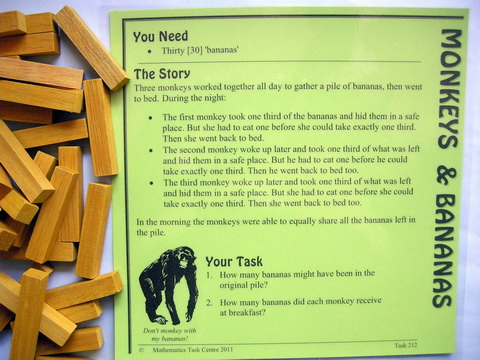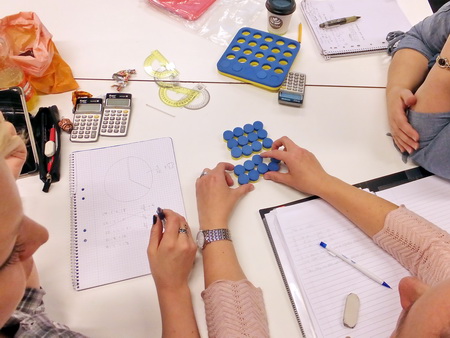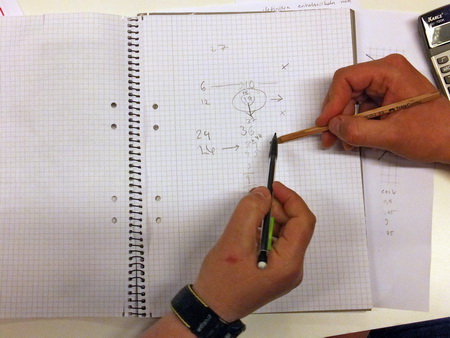
Monkeys & BananasTask 212 ... Years 2 - 10SummaryThree monkeys work all day to collect a big pile of bananas and then flop into bed too tired to eat them. The card then goes on to explain how each monkey got up in the night, ate a banana and then hid one third of the bananas remaining at that time. Despite these night hungries - and displays of selfishness - the monkeys were still able to have equal shares of bananas at breakfast. How many bananas might have been in the original pile.This cameo includes an Investigation Guide which offers a similar problem as an extension. It also has a From The Classroom section which takes up an idea in the whole class lesson notes below and converts the lesson into a Poster Problem Clinic. This is adapted further by Beth Bright into Minions & Bananas complete with mobile phone apps. |
Materials
Content
|

IcebergA task is the tip of a learning iceberg. There is always more to a task than is recorded on the card. |
Some students will begin this problem by guessing a pile number; others by guessing a number the monkeys might have shared at breakfast. Whichever way is chosen the guess will either lead to a fraction of a banana - which doesn't exist in the problem - or will lead to a solution. Along the way, students might discover some, as yet, unrealised information in the problem. For example:
Extensions
Another approach to extension is to offer a related problem as Kerry Wode, St. Thomas the Apostle School, Kambah, has done with this Tale of Two Pyramids Investigation Guide. |
Note: This investigation has been included in Maths At Home. In this form it has fresh context and purpose and, in some cases, additional resources. Maths At Home activity plans encourage independent investigation through guided 'homework', or, for the teacher, can be an outline of a class investigation.
- Visit the Home Page for more Background.
- For this specific activity click the Learners link and on that page use Ctrl F (Cmd F on Mac) to search the task name.
Whole Class InvestigationTasks are an invitation for two students to work like a mathematician. Tasks can also be modified to become whole class investigations which model how a mathematician works. |
Prepare the monkey story as a poster or a slide. Ask students to sit in groups of 3 and hand out 'bananas'. Poly Plug works well, especially if you convert the story to Kids & Cup Cakes (see below). Challenge the groups to find a solution. Perhaps there could be a real banana for each member of the team that finds a solution first. Take time for several groups to explain their reasoning and then ask each group to prepare a poster (or other form of report) to explain how to work out the problem. Raise the possibility of another solution and encourage searching for one. (It may be that groups have already found different solutions.) Encourage students to express their insights into the small step calculations in the problem. First you have to... then you have to... then next you... etc. Introduce the idea that a computer is designed to do perform repetitive calculations like this and suggest exploring how a mathematician uses a spreadsheet to take advantage of the computer's mindless calculation power. This is a great opportunity to justify the school's laptop or tablet computers. Use the spreadsheet to explore every possible morning share number up to say 50 will emphasise that by removing the drudgery of calculation, mathematicians can seek and see patterns, for in fact, a pattern does begin to emerge showing that solutions for the morning share number are separated by 8, ie: 2, 10, 18, ... Other patterns can also be found. In senior classes, pushing the investigation further into one algebraic expression linking the final share number and the original pile helps to show why the difference of 8 occurs. For more ideas and discussion about this investigation, open a new browser tab (or page) and visit Maths300 Lesson 113, Monkeys & Bananas, which also includes a prepared spreadsheet. Visit Monkeys & Bananas on Poly Plug & Tasks. |
Is it in Maths With Attitude?Maths With Attitude is a set of hands-on learning kits available from Years 3-10 which structure the use of tasks and whole class investigations into a week by week planner. |
The Monkeys & Bananas task is an integral part of:
The Monkeys & Bananas lesson is an integral part of:
|
Högskolan MalmöTeacher In-Service Course |
I was asked to run a workshop that included Monkeys & Bananas because these teachers were doing a course in algebra and functions. There weren't enough 'pretend bananas' in the storeroom but there were plenty of Poly Plug, so I decided to use the Kids & Cup Cakes variation. In addition, so these teachers would experience a new teaching craft approach, I prepared this poster and presented the lesson as a Poster Problem Clinic. Show the poster in full screen view using Ctrl L.
The purpose of these clinics is to help students realise the importance of:
The teachers appreciated the application of literacy teaching techniques (story context and read & retell for example) that makes the Poster Problem Clinic much more than just teaching strategies for problem solving and very much needed to use the concrete materials to start their thinking.
|
 |
 |

St. Mary MacKillop College, CanberraBeth Bright |
Hi Doug,
I attended your Professional Learning session entitled 'Numeracy Essentials' held at the Rheinberger Center (ACT) in September. I found the Poster Problem Clinic a very engaging task which clearly taught students to slow down their problem solving so as to maximise understanding of the question prior to solving. I took this strategy back to my school, St Mary MacKillop College, by slightly altering your 'Monkeys and Bananas' activity to one involving 'Minions and Bananas'. I also used my 'Problem Solving Apps' to assist in the process. (Note: The links are to PDF files. Use Ctrl L to toggle between full screen and page views. Use full screen for display). This activity was used in a peer observation lesson to great success. The students were incredibly engaged and realised the value of reading for understanding, rather than just rushing in. I have subsequently passed this activity onto my colleagues at school and thought you also might like a copy of my alteration and Problem Solving Apps. The 'Apps' are just a poster (I wish I was able to develop actual apps...maybe that can be a project for me next year?)...it's just another way of presenting the 'mathematical toolbox'... even my year 9s enjoy playing with the big 'mobile phone', pretending to push the screen when they select an 'app' to use (and inevitably place the poster up to their ears pretending to talk on their 'phone'). Thank you for your inspiration!
Kind regards, |